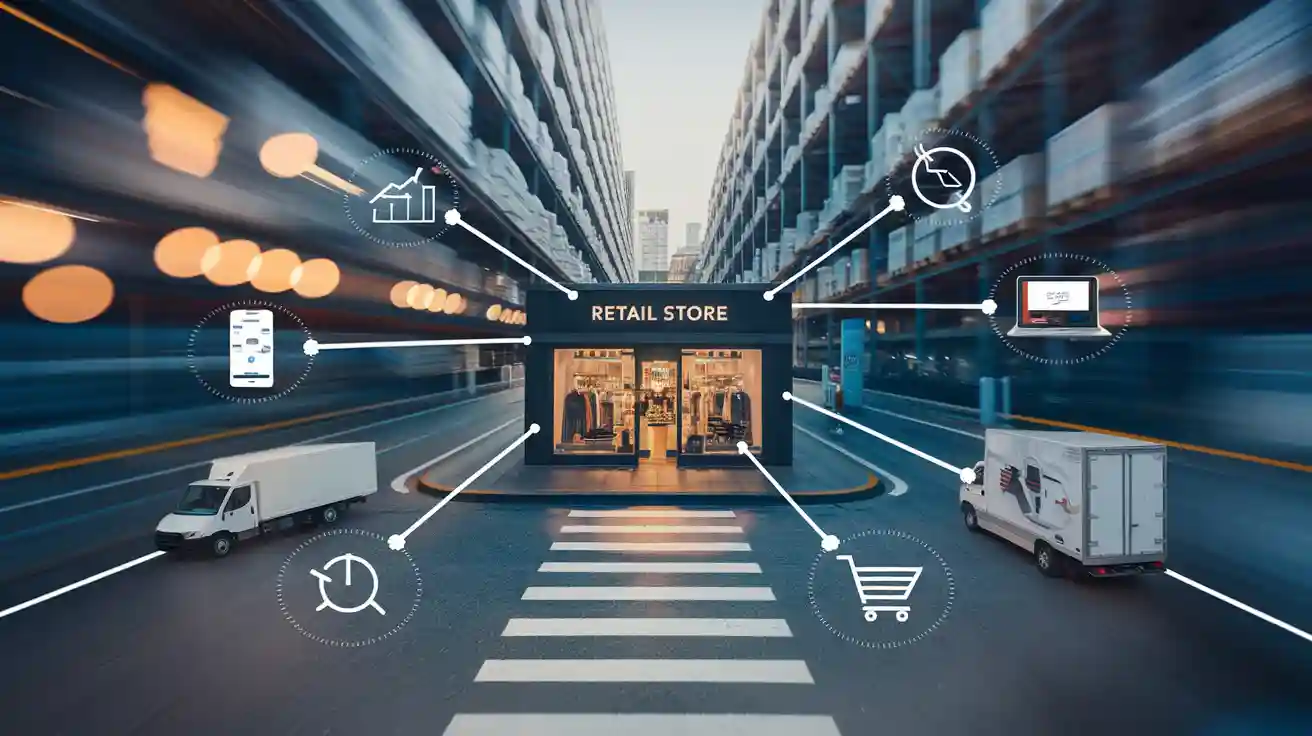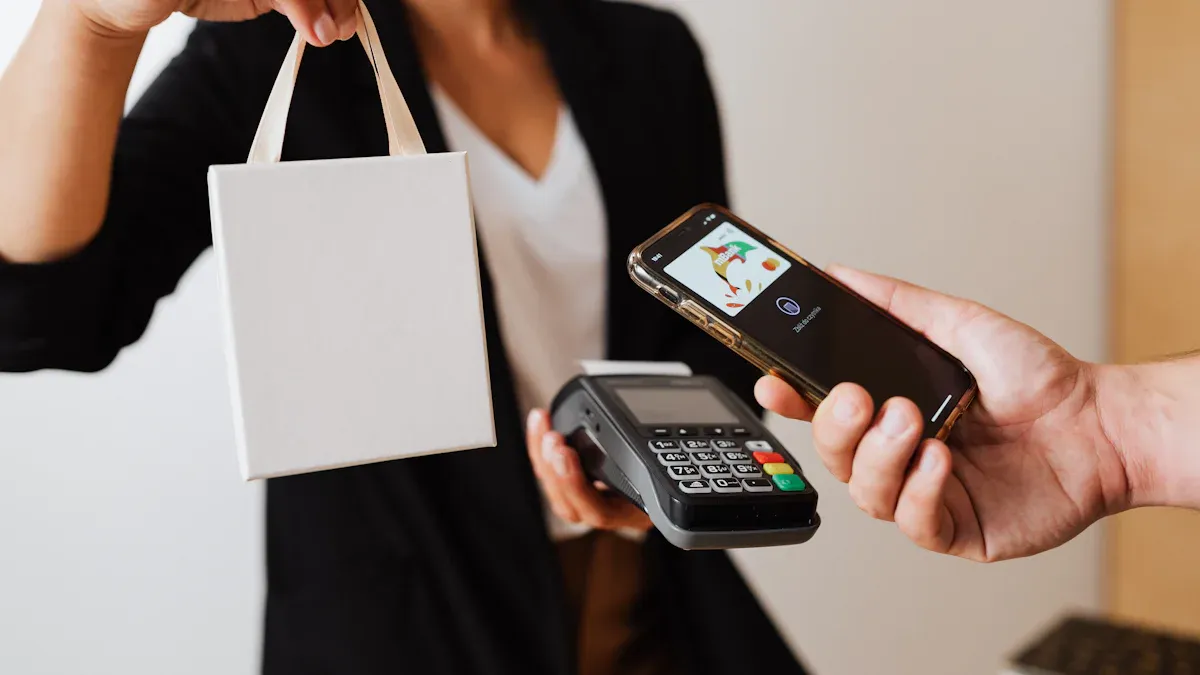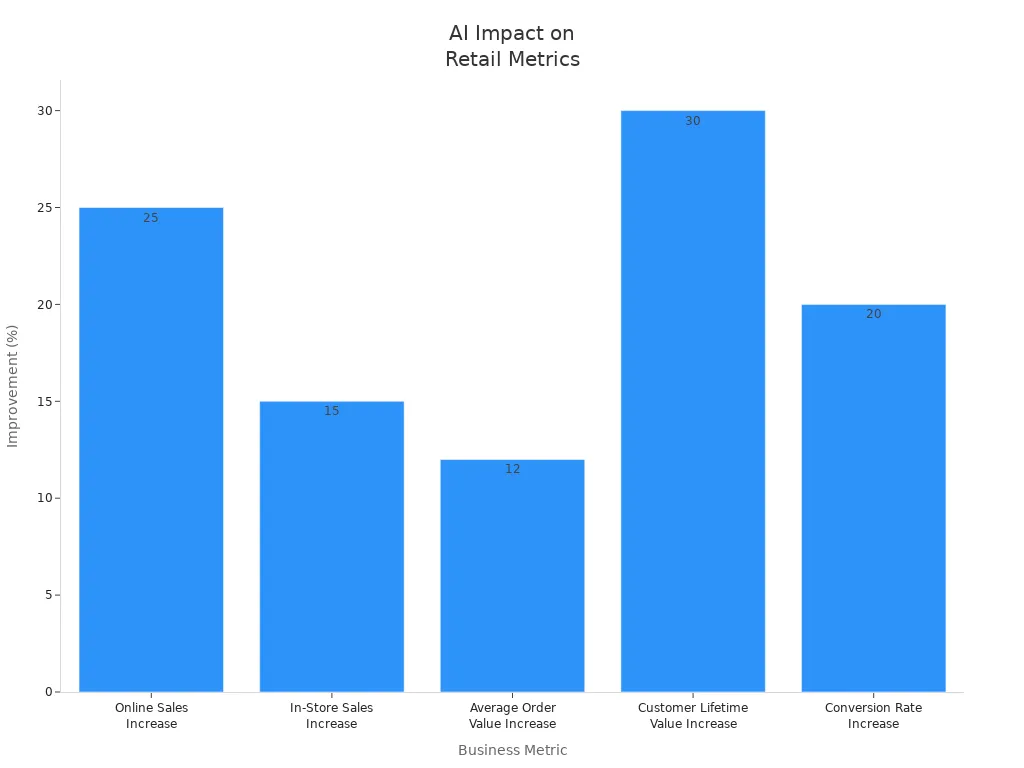Top Omnichannel Distribution Trends for Retail Success

Omnichannel distribution will shape the retail landscape in 2025. Retailers face rapid changes in customer expectations and must adapt their strategy to succeed. Flexible fulfillment, unified commerce, and seamless omnichannel experiences drive growth and satisfaction. The future of omnichannel relies on in-house delivery, micro-fulfillment, and shoppable media. Retailers use omnichannel commerce to optimize inventory, manage costs, and personalize customer journeys. The retail industry must embrace these omnichannel trends to meet the demands of 2025.
2025 Omnichannel Trend Impact on Retail In-house delivery & micro-fulfillment Boosts delivery speed and profitability Shoppable media & social commerce Engages Gen Z and drives sales through new channels AI integration & flexible commerce Enhances service and tailors strategy to customers
Omnichannel Distribution in 2025
Omnichannel distribution has transformed retail by merging physical and digital experiences. In 2025, retailers see this approach as essential for meeting customer expectations and driving growth. The evolution of omnichannel commerce now blurs the lines between online and offline, creating seamless, personalized journeys for every shopper. Retailers invest in smarter supply chains, experiential stores, and technology platforms that connect every touchpoint.
Consumers often switch between devices many times each hour. They expect brands to deliver consistent experiences across all channels. Omnichannel buyers spend more each month than single-channel shoppers, and companies with strong omnichannel strategies retain nearly 90% of their customers.
| Aspect | 2025 Omnichannel Distribution Highlights |
|---|---|
| In-Store Transformation | Stores act as fulfillment centers and offer workshops, demos, and curbside pickup. |
| Social Commerce Integration | Social platforms enable live shopping, shoppable posts, and in-app purchases. |
| Supply Chain Innovations | Last-mile delivery tech, such as drones and autonomous vehicles, improves speed and reliability. |
| Technology Adoption | Platforms like GreyOrange’s gStore boost inventory and fulfillment efficiency across thousands of stores. |
Unified Commerce
Unified commerce brings together customer, inventory, and sales data into one system. This integration allows retailers to manage real-time inventory, offer flexible fulfillment, and personalize shopping experiences. For example, Walmart uses real-time inventory updates to support Buy Online, Pickup In-Store (BOPIS), increasing both efficiency and store traffic. Target’s mobile POS streamlines checkout, making shopping faster and easier. Unified commerce reduces operational silos and improves data accuracy, which leads to a seamless retail environment across multiple channels.
- Real-time inventory management supports live stock updates and flexible order fulfillment.
- Integrated data provides a complete view of customer journeys, enabling better decision-making.
- Enhanced fulfillment options, such as BOPIS and Buy Online, Return In-Store (BORIS), meet rising customer expectations in 2025.
Composable Commerce
Composable commerce gives retailers the flexibility to build and adapt their technology stacks. It uses a modular approach, allowing brands to plug in or swap out tools without disrupting operations. This open ecosystem lets retailers choose the best SaaS products and integrate them easily, reducing vendor lock-in. MACH architecture—Microservices, API-first, Cloud-native, Headless—supports independent development and quick scaling.
- Modular systems speed up time-to-market and support rapid changes in 2025.
- Open ecosystems allow deep customization and easy integration of new tools.
- Flexibility helps retailers expand into new markets and channels, adapting to evolving customer needs.
- Composable commerce reduces costs, minimizes risk, and future-proofs retail businesses for ongoing omnichannel success.
Seamless Shopping Experiences

Integrated Online and Offline
Retailers in 2025 recognize that customers expect a seamless experience across every channel. They move easily from browsing online to visiting stores, often using mobile apps to research products before making a purchase. Research shows that integrating online and offline channels creates a unified journey. Customers can research online, try products in-store, and complete purchases through mobile apps. Strategies like buy online, pick up in store (BOPIS) combine convenience and immediacy. These approaches reduce shipping costs and drive in-store sales. Retailers also use stores as mini-distribution centers, which improves logistics and customer convenience. Advanced technologies such as AI and machine learning enable personalization across all touchpoints, increasing loyalty and sales.
| Retailer | Strategies Implemented | Benefits Observed |
|---|---|---|
| Amazon | Personalized recommendations, one-click checkout, easy returns | High satisfaction, loyalty, market dominance |
| Walmart | Omnichannel integration, improved navigation, personalized communication | Higher satisfaction, conversion, repeat purchases |
| Sephora | AI-driven recommendations, interactive in-store experiences, seamless loyalty program | Engagement, loyalty, increased sales |
Retailers use several effective strategies to create an integrated shopping experience:
- Unique coupon codes for both online and offline use
- QR codes in-store for exclusive online offers
- Comprehensive loyalty programs
- Consistent branding and messaging
- Unified promotions and clear communication
- Data-driven marketing improvements
- Customer feedback through surveys and reviews
Frictionless Checkout
A smooth checkout process is essential for a positive customer experience. Studies reveal that the average global cart abandonment rate is about 71.7%, with mobile users abandoning carts even more often. Simplifying checkout can increase conversion rates by 35% for large e-commerce sites. Leading companies like Amazon and Alibaba invest in frictionless checkout technologies, such as one-click shopping and facial recognition payments. ReplaceDirect reduced its cart abandonment rate by 25% after optimizing its checkout flow. A Kantar study found that reducing payment processing time by just a few seconds can significantly improve customer satisfaction scores. In fact, 90% of shoppers say a smooth checkout experience is a deciding factor in completing a purchase. Retailers who prioritize frictionless checkout see higher conversion rates and greater customer loyalty.
AI in Omnichannel Retail
Personalization
Artificial intelligence is transforming omnichannel retail by making personalized shopping journeys possible at scale. Retailers now use AI to analyze customer data from every channel, creating personalized experiences that match each shopper’s preferences. AI-driven segmentation helps brands target customers with the right offers at the right time. For example, 80% of consumers say they are more likely to engage with companies that provide personalized experiences. Generative AI tools, such as chatbots and visual search, help shoppers find products faster and enjoy more personalized shopping journeys. These tools also reduce cart abandonment by offering personalized discounts and recommendations.
| Evidence Aspect | Data / Example |
|---|---|
| Consumer Preference for Personalization | 80% of consumers are more likely to engage with companies offering personalized experiences. |
| Impact of AI-triggered Discounts | Personalized discounts reduce cart abandonment and increase customer engagement. |
| Behavioral Segmentation Effectiveness | AI-driven segmentation enables targeted marketing that increases purchase frequency. |
| Generative AI Shopping Experience | 87% of shoppers who used generative AI tools report positive impacts on their shopping experience. |
| Openness to AI Chatbots | 73% of consumers are open to AI-powered chatbots for customer service, enhancing engagement. |
| Demand Forecasting Accuracy | AI-driven demand forecasting reduces forecast errors by up to 30%, improving inventory planning. |
| Automated Replenishment Benefits | Automated replenishment reduces stockouts by up to 40%, supporting sales through product availability. |
Retailers who invest in AI-powered personalization see higher engagement and loyalty. Personalized shopping experiences drive repeat purchases and help brands stand out in a crowded market.
AI-Powered Service
AI-powered service tools are changing how retailers interact with customers in omnichannel retail. Chatbots, virtual assistants, and voice commerce provide instant support and answers, making shopping easier and more enjoyable. Retailers using generative AI-powered shopping assistants have reduced call center volumes by up to 30%. These tools also improve operational efficiency and customer satisfaction. Medium-sized retailers report up to a 30% increase in customer lifetime value after adopting AI-driven omnichannel strategies. AI also supports unified commerce platforms, ensuring seamless experiences across online, in-store, and mobile channels.

A major retailer using an omnichannel AI solution saw a 25% increase in online sales, a 15% rise in in-store sales, and a 20% boost in conversion rates. AI-powered service not only enhances personalized shopping experiences but also streamlines inventory management and supports real-time decision-making. As omnichannel retail evolves, AI will continue to drive innovation, helping retailers deliver the personalized experiences customers expect.
Effective Omnichannel Strategy
A successful retail business in 2025 depends on an effective omnichannel strategy. Retailers must connect every customer touchpoint and create a seamless journey. Industry reports highlight five essential elements for building an effective omnichannel strategy:
- Audit all customer interactions to identify pain points and opportunities.
- Bridge gaps between channels for smooth transitions, such as linking social media to e-commerce.
- Personalize services by using customer data and enabling real-time assistance.
- Continuously analyze performance and feedback to improve and prevent inconsistencies.
- Adjust and optimize the strategy to stay flexible and relevant.
Retailers who follow these steps can deliver a consistent and satisfying experience across every channel.
Flexible Fulfillment
Flexible fulfillment has become a core part of any effective omnichannel strategy. Retailers now offer options like BOPIS (Buy Online, Pick Up In Store), ROPIS (Reserve Online, Pick Up In Store), BORIS (Buy Online, Return In Store), and BOPAC (Buy Online, Pick Up at Curbside). These choices blend online and in-store experiences, making shopping easier for customers. Automation in order processing reduces errors and speeds up operations. Real-time inventory synchronization and order routing help retailers fulfill orders quickly and accurately. Automated communications and tracking keep customers informed, which increases satisfaction.
A recent study shows that flexible logistics, such as allowing customers to change delivery dates after placing an order, benefits both retailers and shoppers. Customers enjoy more control, while retailers align services with real needs. Customization and flexibility are now critical for omnichannel fulfillment success.
Retailers face challenges like integrating technology, managing inventory, and meeting high customer expectations. They overcome these by investing in integrated platforms, training staff, and using real-time data.
Click and Collect
Click and collect services have become a standard part of the effective omnichannel strategy. Hybrid shopping methods, including BOPIS and curbside pickup, are now expected by customers. Since late 2020, global click and collect usage has grown by 10%. In Norway, 31% of consumers see click and collect as a key reason to buy, more than double the global average. Retail stores now act as fulfillment hubs, giving clear inventory visibility and a competitive edge. Fast and flexible fulfillment options, such as click and collect, build customer loyalty.
| Trend or Benefit | Description |
|---|---|
| Hybrid Shopping | Customers expect to blend online and in-store experiences |
| Growth in Click and Collect | 10% global increase since Q4 2020 |
| Store as Fulfillment Hub | Retailers use stores for inventory and order pickup |
| Customer Loyalty | Fast, flexible options increase repeat business |
Retailers who invest in click and collect as part of their omnichannel strategy see higher satisfaction and more frequent purchases. They also gain better inventory control and improved store traffic.
In-House Delivery & Last Mile
Fast Delivery Options
Retailers in 2025 recognize that fast delivery options drive customer loyalty and repeat business. Shoppers expect their orders to arrive quickly and on time. Companies that meet these expectations see higher revenue, satisfaction, and brand loyalty. A recent survey found that 67% of consumers value on-time delivery, while 49% care about low loss rates. Retailers who offer reliable last-mile delivery gain a competitive edge.
Many brands now use innovative strategies to speed up delivery:
- Autonomous vehicles and drones reduce delivery times and environmental impact. Amazon and UPS have tested these technologies.
- Smart lockers and pickup points give customers secure, flexible ways to receive packages.
- Real-time tracking and delivery updates keep shoppers informed and build trust.
- Crowdsourced delivery models, such as Uber and Postmates, help retailers scale up during busy periods.
- Regional carriers work alongside national carriers to improve speed and resilience.
Retailers like Amazon use crowdsourced delivery, smart lockers, and in-home delivery to cut costs and boost flexibility. Walmart combines in-store pickup, grocery delivery, and membership programs for same-day service. DoorDash uses AI to plan routes and batch orders, making deliveries faster and more efficient. These strategies help retailers win sales and keep customers coming back.
Tip: Reliable, fast delivery not only increases revenue but also strengthens customer relationships. Poor delivery experiences can drive shoppers to competitors.
Micro-Fulfillment
Micro-fulfillment centers (MFCs) have become a game-changer for omnichannel retail. These small, automated warehouses sit close to customers, often inside existing stores or nearby locations. MFCs use robotics and automation to pick and pack orders quickly, reducing labor costs and speeding up fulfillment. Retailers like Walmart and Albertsons use MFCs to deliver online orders faster.
Key benefits of micro-fulfillment include:
- Faster order processing and same-day delivery
- Lower shipping costs due to proximity to customers
- Efficient inventory management with localized stocking
- Better use of underutilized retail space
However, retailers face challenges when setting up MFCs:
- High initial investment in technology and infrastructure
- Complex inventory tracking across multiple centers
- Need for staff training and adaptation to new systems
- Zoning and regulatory hurdles in urban areas
To succeed, retailers assess demand, choose scalable automation, and integrate MFCs with their supply chain. They often pilot new centers before expanding. Data analytics helps manage inventory and plan for demand changes. Partnerships with reliable delivery providers ensure smooth operations. As automation grows, retailers must balance technology with a positive customer experience.
| Benefit | Description |
|---|---|
| Speed | Enables same-day or next-day delivery |
| Cost Savings | Reduces shipping and labor costs |
| Flexibility | Adapts to demand and supports omnichannel |
| Space Utilization | Uses existing retail or underused areas |
Shoppable Media & Social Commerce

Social Shopping
Social shopping has changed how people discover and buy products. Today, shoppers use platforms like Facebook, Instagram, and Twitter to find new items and make purchases without leaving the app. The global social commerce market reached $1.16 trillion in 2024 and is projected to grow to $17.83 trillion by 2033, with a CAGR of 36.4%. Asia Pacific leads this trend, holding over 70% of the global market share. The rise of 4G smartphones and mobile internet has made social shopping more accessible, especially for younger consumers.
| Metric | Value |
|---|---|
| 2024 Global Market Size | USD 1.16 trillion |
| 2033 Projected Market Size | USD 17.83 trillion |
| CAGR (2025-2033) | 36.4% |
| Asia Pacific Market Share 2024 | 71.6% of global market share |
| U.S. CAGR (2025-2033) | 32.4% |
Retailers use shoppable posts, live-stream shopping, and in-app checkout to create interactive experiences. These features reduce barriers to purchase and increase conversion rates. Social shopping also encourages real-time discussions, brand communication, and community recommendations. Generation z prefers these integrated experiences, often sharing products with friends and trusting peer reviews. Brands that use omnichannel marketing strategies can reach customers across social, mobile, and in-store channels.
Tip: Personalized content feeds, easy sharing, and direct customer support help build trust and loyalty in social commerce.
Influencer Integration
Influencers play a key role in modern retail campaigns. They create authentic content that connects with followers and drives engagement. Successful tactics include sponsored posts, unboxing videos, hashtag challenges, and live shopping events. These methods allow influencers to showcase products in real-life settings, making recommendations more trustworthy.
- Sponsored posts blend products into daily content.
- Unboxing and reviews offer firsthand experiences.
- Hashtag challenges boost visibility and participation.
- Tutorials and behind-the-scenes content educate and engage.
- Live shopping events create excitement and immediate sales.
Brands like Sephora and Target have excelled by integrating influencers into their omnichannel efforts. Sephora’s influencers demonstrate app features and in-store experiences, while Target partners with Pinterest to connect visual search with product suggestions. These examples show how influencers can act as a distinct channel, meeting consumers wherever they shop.
Sustainability in Omnichannel
Eco-Friendly Logistics
Retailers now see eco-friendly logistics as a core part of omnichannel success. They use recyclable and recycled packaging with minimal designs to cut waste. Many companies choose ground-based shipping and electric vehicles for last-mile delivery. These changes lower carbon emissions and meet growing consumer demand for green products. In the United States, over half of consumers say they will pay more for low-carbon options. Retailers also use micro-fulfillment centers and regional supply chains to shorten delivery distances. This reduces fuel use and speeds up shipping.
Companies that optimize delivery routes and use digital tools like RFID and big data analytics improve both efficiency and sustainability. Paperless receipts and e-catalogs help reduce physical waste. Some brands offer reward programs for customers who pick eco-friendly delivery options. Others partner with green third-party logistics providers to expand their impact.
Retailers also focus on transparency and ethical sourcing. Blockchain technology helps track products and prove their origins. Automation in warehouses cuts energy use and improves inventory management. These steps help retailers comply with regulations and build trust with eco-conscious shoppers.
Circular Retail
Circular retail models help retailers reduce waste and extend product life cycles. Many brands now run recycling and upcycling programs that reward customers for returning used items. These programs support a circular economy and lower environmental impact. Retailers also design products for reuse and easy recycling.
- In-store collection points for returns and recycling
- Incentives for customers who bring back used goods
- Upcycling initiatives that turn old products into new items
Digital technologies play a key role in circular retail. Generative AI and big data analytics help retailers predict returns and manage inventory. Companies tailor replenishment and logistics strategies by product type and location to balance profit and sustainability. Hybrid storefronts combine physical stores, digital warehouses, and low-emission vehicles for a greener approach.
Retailers who invest in circular models and eco-friendly logistics see better financial, environmental, and social performance. These strategies not only protect the planet but also strengthen brand reputation and customer loyalty.
Retailers in 2025 must embrace the future of omnichannel by prioritizing flexibility, unified commerce, and customer-centric strategy. Key omnichannel trends include immersive in-store experiences, AI-driven personalization, and diversified fulfillment options. To futureproof their strategy, retailers should:
- Assess current planning and define clear objectives.
- Invest in AI-powered analytics and real-time inventory visibility.
- Foster continuous improvement and adapt to evolving customer needs.
The future of omnichannel will reward those who innovate and respond quickly to changing retail trends and customer expectations.
FAQ
What is omnichannel distribution in retail?
Omnichannel distribution connects all sales and fulfillment channels. Retailers use it to give customers a seamless experience. Shoppers can buy, return, or pick up products in stores, online, or through mobile apps.
How does AI improve the omnichannel experience?
AI helps retailers understand customer behavior. It powers personalized recommendations, automates service, and predicts demand. Retailers use AI to manage inventory, speed up checkout, and offer real-time support.
Why is flexible fulfillment important for retailers?
Flexible fulfillment lets retailers meet customer needs quickly. They offer options like curbside pickup, same-day delivery, and in-store returns. This approach increases satisfaction and builds loyalty.
How can retailers make their omnichannel strategy more sustainable?
| Practice | Impact |
|---|---|
| Eco-friendly packaging | Reduces waste |
| Electric delivery vans | Lowers carbon emissions |
| Recycling programs | Extends product life cycles |
Retailers use these steps to protect the environment and meet customer expectations.